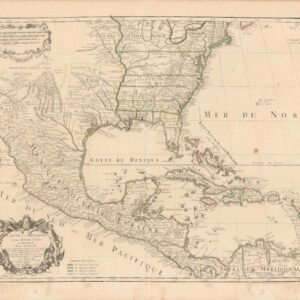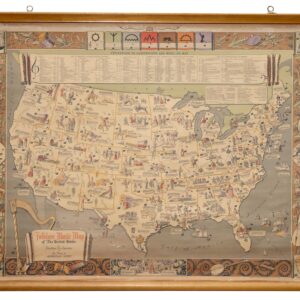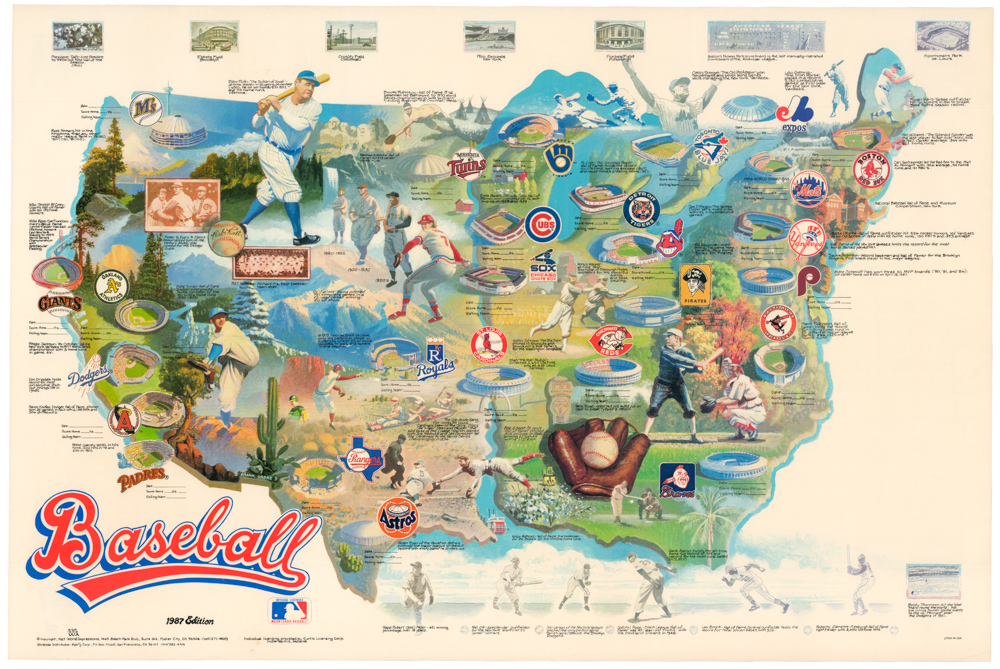William McKinley & Uncle Sam: a wonderful 1899 persuasive map advocating for the construction of the Nicaragua Canal.
A THING WELL BEGUN IS HALF DONE. UNCLE SAM—“Finish the canal, McKinley, and make our national expansion complete in your first administration.”
$1,200
1 in stock
Description
The magazine Judge published a number of cartographic cartoons favoring American expansionism, among them this one boosting the Nicaragua canal project. The map depicts the United States and its new globe-spanning empire; flags delineate Cuba and Puerto Rico as American territories, along with Alaska, the Philippines, and Hawaii, with the scale compressed so that the latter two lie just off the West Coast. President McKinley stands like a colossus astride the Gulf of Mexico, while Uncle Sam rushes him an armful of tools. P.J. Mode describes the image as follows:
“A satirical political cartoon reflecting America’s imperial ambitions following quick and total victory in the Spanish American War of 1898. In June of 1899, Congress had authorized and President McKinley had appointed the Isthmian Canal Commission, charged with making a “full and complete investigation as to determine the most feasible and practicable route across [the] isthmus for a canal… under the control, management, and ownership of the United States.” By the fall of 1899, McKinley’s popularity was high and he seemed likely to be reelected (as he eventually was, with Theodore Roosevelt as Vice-President).
“The American flag flies from the Philippines and Hawaii (annexed during the War as a strategic way station) in the Pacific to Cuba and Puerto Rico in the Caribbean. President McKinley stands with one foot on U. S. soil and the other on Mexico, pick axe in hand, rolling up his sleeves to dig the Nicaraguan canal. (Mexico is badly distorted, with its northern border shown below Baja California, thus improperly enlarging the apparent size of the U.S.) Bound from Hawaii and Manila and the West Coast, “American Goods for Foreign Countries” are lined up to pass through the canal to Europe. An eager Uncle Sam is bringing more tools from Washington, saying (in the caption below), “Finish the canal, McKinley, and make our national expansion compete in your first administration.””
The Dream of a Nicaraguan Interoceanic Canal
The dream of constructing an interoceanic canal across Nicaragua is a centuries-long international saga, one that seesawed back and forth. Indeed, it seemed that just at the very moment when circumstances within Nicaragua permitted the project to become a reality, global events interceded and swept even the best-laid plans away.
The notion of constructing a canal across the isthmus of Central America in order to connect the Atlantic with the Pacific Oceans has been explored since the 16th century. Possible routes included traversing Nicaragua, Panama, Mexico’s Isthmus of Tehauntepec, and even a channel from Colombia’s Gulf of Darién to the Pacific. The distance across the isthmus was tantalizingly short compared to the long sailing route around Cape Horn.
The natural geography of Nicaragua seemed, on the face of it, to be far more accommodating than the alternatives. Lake Nicaragua, with an average surface elevation of only 33 meters (107 feet), was connected to the Caribbean Sea by the Río San Juan, which was navigable for small vessels. All that separated the lake from the Pacific was the narrow Rivas Isthmus, only 12 miles (19 km) wide at tis narrowest. Although elevated, it could conceivably be crossed by a canal with locks. As early as 1551, the Spanish colonial regime commissioned a feasibility study, although the costs and technical challenges proved prohibitive.
Lake Nicaragua’s easy connection with the Atlantic came to the fore in 1665, when an expedition led by the legendary pirate Henry Morgan was able to row up the Río San Juan in 12-metre long canoes and sack Granada, the wealthy city along the shores of the lake.
The idea of constructing a canal across the Rivas Isthmus was revived in 1781, when the Spanish commissioned surveys, although once again financial constraints killed the project.
It was only during the 19th century, after the Industrial Revolution, that such a project was considered technically feasible, even if many of the traditional challenges remained problematic.
Following the era of Latin American revolutions, the newly founded Federal Republic of Central America (FRCA), which comprised Guatemala, Honduras, Nicaragua and Costa Rica, seriously investigated building a canal across Nicaragua. In 1825, the FRCA government commissioned surveyors to chart a viable route. However, the key issue was that no country in the region possessed anything near the enormous capital required, nor the ability to marshal the immense technical expertise to fulfill such a project. The assistance of an outside industrial super-power, namely Britain, the United States or France was necessary.
The FRCA authorities contacted the U.S. Government, asking them to sponsor the project. While President John Quincy Adams thought the idea had merit, in 1826 it was rejected by Congress. American legislators were worried about the cost, political instability in Nicaragua, as well as the possibility of offending Britain, which still claimed the Mosquito Coast (much of the Caribbean littoral regions of Nicaragua and Honduras).
The California Gold Rush and the U.S. acquisition of vast territories bordering the Pacific during the Mexican-American War (1845-8) revived American interest in an interoceanic canal in Central America. That being said, for the U.S., or any other foreign power, to invest the vast resources necessary to build a trans-isthmus canal, they would have to be confident that they exercised sufficient political influence, if not direct control, over the country in which the canal was to be located. Mexico was an enormous and politically unstable nation, and exercising enduring control over the country would be a prohibitively Herculean endeavor. Panama was a province of the Republic of Colombia, a large country controlled by a sophisticated elite, with its capital, Bogota, located deep in the Andes. Controlling Colombia would be a feat beyond even the most aggressive imperialist’s abilities.
On the other hand, while Nicaragua, which had become an independent republic in 1838 (following the dissolution of the FRCA), was prone to political instability, it was a small nation, which could supposedly be invaded and controlled by a European or American force with relative ease, if necessary.
The American tycoon Cornelius Vanderbilt moved quickly. In 1849, he made an agreement with the Nicaraguan government for his Accessory Transit Company to be given exclusive rights to build the canal across he country within the next 12 years. Moreover, until the canal was completed, it was permitted to operate a monopoly transport route, by steamboat and stagecoach, across Nicaragua. Significantly, this opened the quickest route between New York and San Francisco.
Meanwhile, the Clayton–Bulwer Treaty (1850), between the U.S. and Britain, gave tacit British approval to American designs to build the trans-Nicaragua canal, in exchange for Washington’s acceptance of the British presence on the Mosquito Coast. The way now appeared open for the Americans to realize the long-held dream.
However, dramatic events in Nicaragua, ironically driven by an American citizen, extinguished U.S. plans to built the canal. In 1854, Nicaragua fell into a civil war, fought between its two main political parties. In 1855, William Walker, the American ‘Filibuster,’ took advantage of the situation, arriving in the country with small force of crack troops. The following year, allied with the forces of the Liberal Party, he managed to take over much of the country, declaring himself President. He shutdown Vanderbilt’s transport line, planning to take over the canal project for himself. However, in 1857, the combined forces of the Conservative Party and the forces of other Central American countries ran Walker out of the country.
In spite of the restoration of order in Nicaragua, American enthusiasm for building the canal fell to an all-time low. The Walker melodrama frightened investors and stoked anti-American sentiment throughout Nicaragua’s ruling Conservative party. Moreover, the United States was in the process of being torn apart by internal cleavages that would lead to the U.S. Civil War (1861-5).
Britain, another potential suitor for the canal, found itself preoccupied, notably by its huge debts from the Crimean War and a Rebellion in India (1857-8). London lost all interest in Central America, and with the Treaty of Managua (1860), it surrendered suzerainty of the Mosquito Coast, between Cabo Gracias a Dios and Greytown, to Nicaragua.
The initiative for building the trans-Nicaragua Canal thus fell to France, at that time ruled by the grandiose and quixotic Emperor Napoleon III, a long-time enthusiast of the canal project. France was entering a period of muscular global expansion and sponsored military expeditions and economic mega-projects all across the globe, from Latin America to Vietnam. Of specific relevance, France possessed the most advanced civil engineering capabilities in the world, and its expertise in canal construction was second to none. In 1854, Ferdinand de Lesseps negotiated the concession with the Pasha of Egypt that would lead a French consortium to construct the Suez Canal (completed in 1869). For a time it seemed that France was certain to seize the initiative – creating and controlling both of the great interoceanic canals.
It was in this context that Belly’s endeavor was undertaken. However, its failure discouraged further French attempts towards building a canal in Nicaragua. Moreover, France’s involvement in military actions in Italy (1859-61) and, more importantly, the calamitous French Intervention in Mexico (1862-7), drained the nation’s resources and its enthusiasm for epic adventures in the Americas.
In the wake of the Union victory in the U.S. Civil War, the United States reasserted its prerogative under the Monroe Doctrine to control affairs in its hemisphere and to, once gain, embrace the dream of an interoceanic canal in Central America. As a prelude to this, they made sure that whatever was left of the French presence in Nicaragua was sent packing.
In 1872, representatives of U.S. President Ulysses Grant engaged Nicaragua’s leadership with their desire to sponsor a canal across Nicaragua. In particular, they corresponded with Maximilian von Sonnenstern, Nicaragua’s highly competent official state engineer. The Americans held the courtly, German-born Sonnenstern in high regard, and the discussions were remarkably amicable, with both sides seeming to want to build a symbiotic relationship.
In 1874, Sonnenstern travelled to Washington, D.C., as the head of a Nicaraguan delegation, whereupon he was fêted by cabinet secretaries, congressman, engineers and potential investors. Sonnenstern’s proposal for the canal, Report on the Nicaragua route for an inter-oceanic ship-canal, with a review of other proposed routes; made by Maximilian von Sonnenstern to the minister of public works of Nicaragua (1874), was published for the United States Coast Survey by the U.S. Government Printing Office.
But once again, events conspired to scuttle the best-laid plans. The global economic Depression of 1873–79 threw cold water on American enthusiasm for a mega-project. Moreover, the success of the Central Pacific Railroad (completed in 1869), the first transcontinental railway in North America, somewhat lessened the urgency of an interoceanic canal.
In 1881, the irrepressible Ferdinand de Lesseps headed a French consortium that commenced building a canal across Panama. This proved to be one of the great disasters in the history of modern engineering. Not only did the enterprise go bankrupt, landing Lesseps and his associates in court for fraud, but by 1894 the project had wasted U.S. $287 million and cost the lives of 22,000 workers.
The initially promising prospect that the French would be successful naturally held up any action on the Nicaragua Canal. However, once it became clear that Panama project was a disaster, movement on the Nicaragua file resumed, although the horrific spectacle in Panama caused considerable trepidation, such that any action was half-hearted.
In 1888, the U.S. Congress chartered the Nicaragua Canal Company and modest efforts were made to survey the canal route and to clear brush along its path. However, illness started to take members of the work parties, and many feared that they were headed for a repeat of the Panama nightmare.
In 1895, the Nicaragua project received another blow when the respected Swiss engineer Henri François Pittier, then a resident of nearby Costa Rica, wrote a damning report that suggested that that any canal route from the Caribbean to Lake Nicaragua would be plagued by chronic flooding and landslides and, moreover, that the region was subject to seismic activity that could easily destroy an canal. The Nicaragua project was now on life-support.
Enter Philippe-Jean Bunau-Varilla, an extremely clever, yet amazing disreputable French investor and showman. He was one of the only people who had made a fortune from the debacle in Panama as a land speculator and contractor. He still owned immense amounts of property along the canal route in Panama, and had excellent connections with the local government and people. If the canal project could be revived in Panama, he stood to multiply his fortune many times over.
In 1898, Bunau-Varilla hired America’s first super-lobbyist, William Nelson Cromwell, to go to any lengths to convince Congress to kill the Nicaragua project and to instead build the canal in Panama. The U.S. was in an expansionist mood, having just annexed Hawaii, and having gained many Pacific islands following its victory in the Spanish-American War. America was now more eager than ever to build the interoceanic canal.
The catastrophic 1902 eruption of Mont Pelée on Martinique created a global media spectacle and great phobia of volcanoes. Cromwell brilliantly took advantage of this, planting a story in the New York Times that grossly exaggerated the danger to the Nicaragua Canal route posed by the Momotombo Volcano, located along the northwestern shore of Lake Nicaragua (in reality, the danger was very remote). Readers of the Times could be forgiven for believing that Mombotombo was a ticking time bomb that could, and would, destroy any Nicaragua canal without warning. To underscore the point, Cromwell sent every congressman a recently printed official Nicaraguan postal stamp that featured a picture of a smoking Mount Mombotombo. The ruse worked, and the Nicaragua Canal project was dead. So grateful was Bunau-Varilla that he paid Cromwell U.S. $800,000 – a sum so enormous that, adjusted for inflation, it is likely still a world record for a lobbying fee.
However, Bunau-Varilla was no done. His next plan was to make Panama into a ‘banana republic’ that the U.S. and his canal syndicate could completely control and manipulate at-will. The government of Colombia, of which Panama was a part, was proving uncooperative, and Colombia was far too large for external forces to control. In 1903, Bunau-Varilla took advantage of the low-grade separatist sentiment that existed amongst the Panamanian population to manufacture a ‘popular rebellion’ for the ‘freedom’ of Panama. This design had President Theodore Roosevelt’s active support, and Colombia, which had just endured a brutal civil war, was in no position to stop Panama from declaring ‘independence’ later that year.
The rest is history. In 1904, the United States purchased the French rights and property of the Panama Canal project and managed to gain sovereignty of the ‘Canal Zone’ from the “grateful” Panamanian nation. The Panama Canal was built, albeit at great cost in blood and treasure, opening for traffic in 1914.
Cartographer(s):
Frederick Victor Gillam (ca. 1858 – January 29, 1920) was a political cartoonist, known for his work in Judge magazine for twenty years, as well as the St. Louis Dispatch, Denver Times, New York World, and New York Globe.
Gillam was a member of the New York Press Club and Lotos Club. Born in Yorkshire, England, he emigrated to the United States at age six. His notable work included support of William McKinley’s 1896 presidential campaign. The younger brother of famed cartoonist Bernhard Gillam (1856–1896), he signed his work “Victor” or “F. Victor” until his brother’s death. Victor died at Kings County Hospital and was buried in Evergreens Cemetery, Brooklyn.
Condition Description
Excellent.




